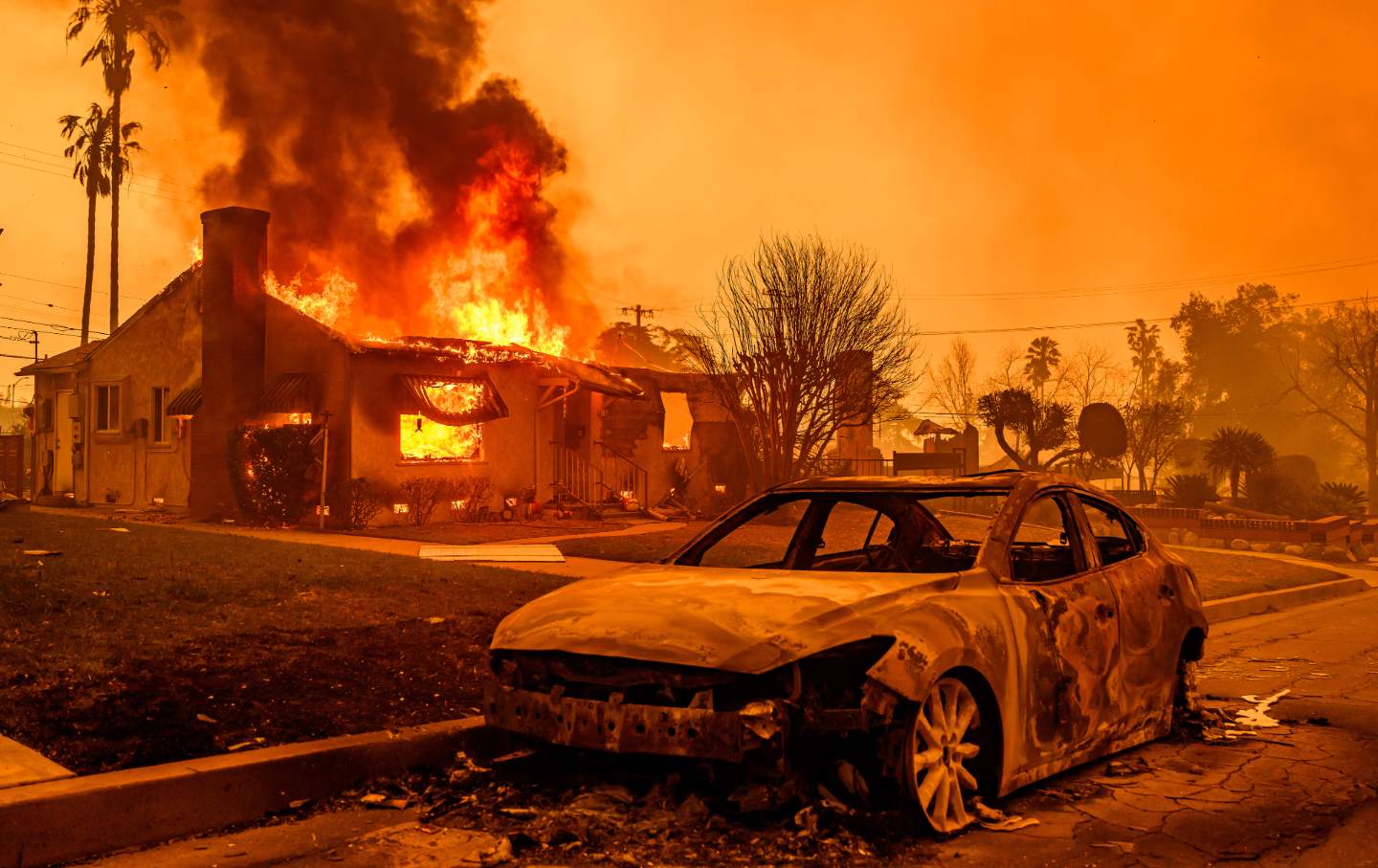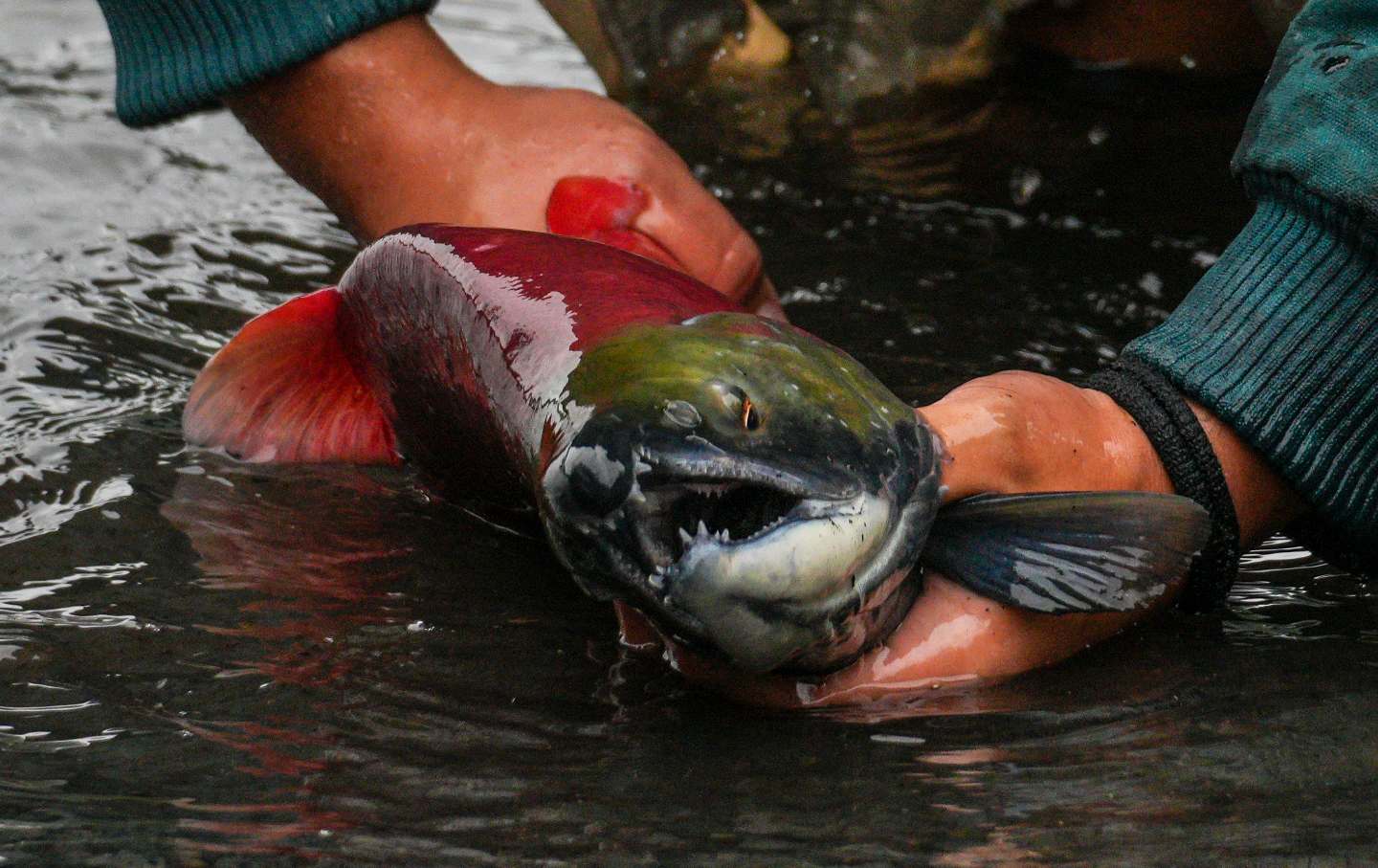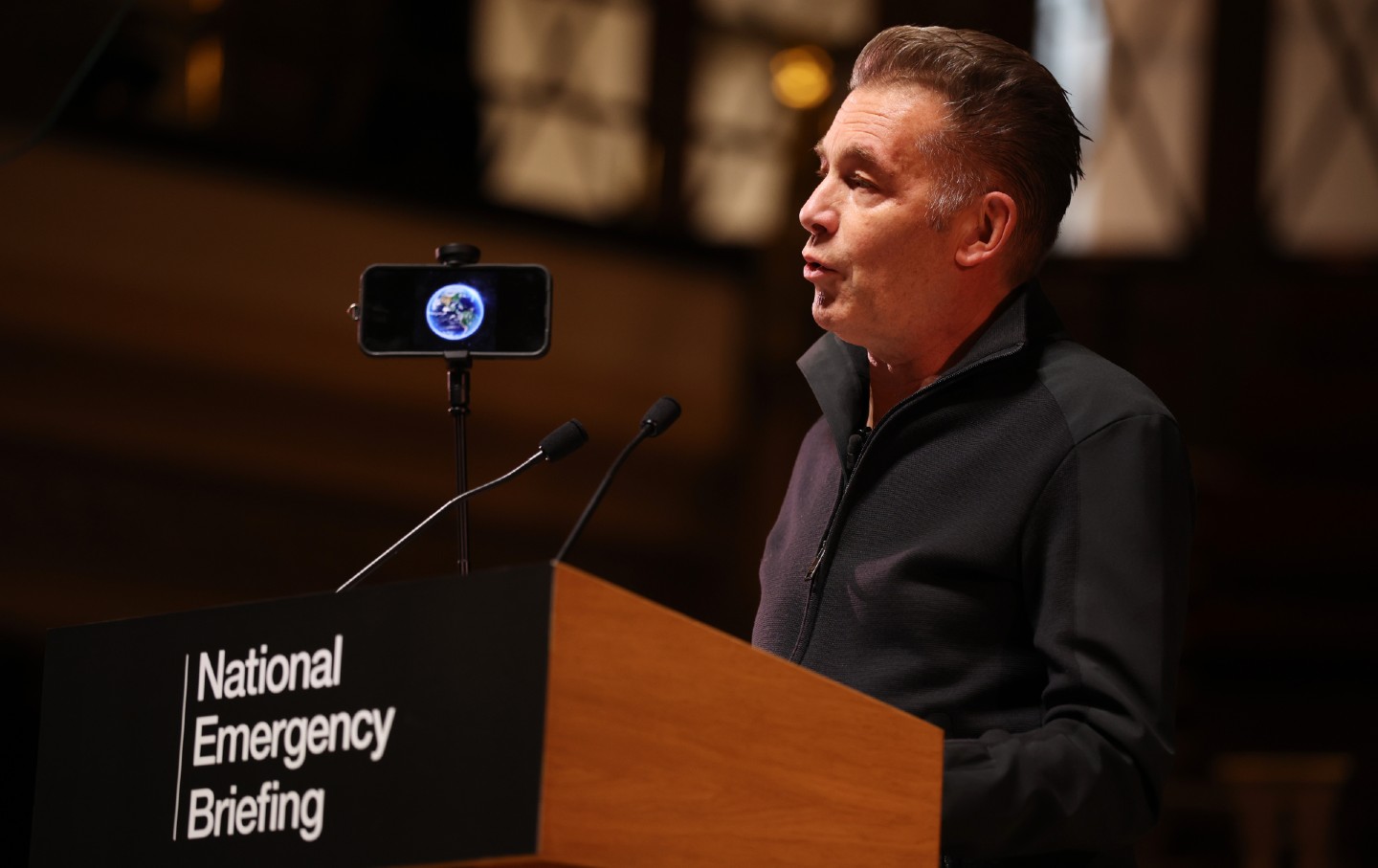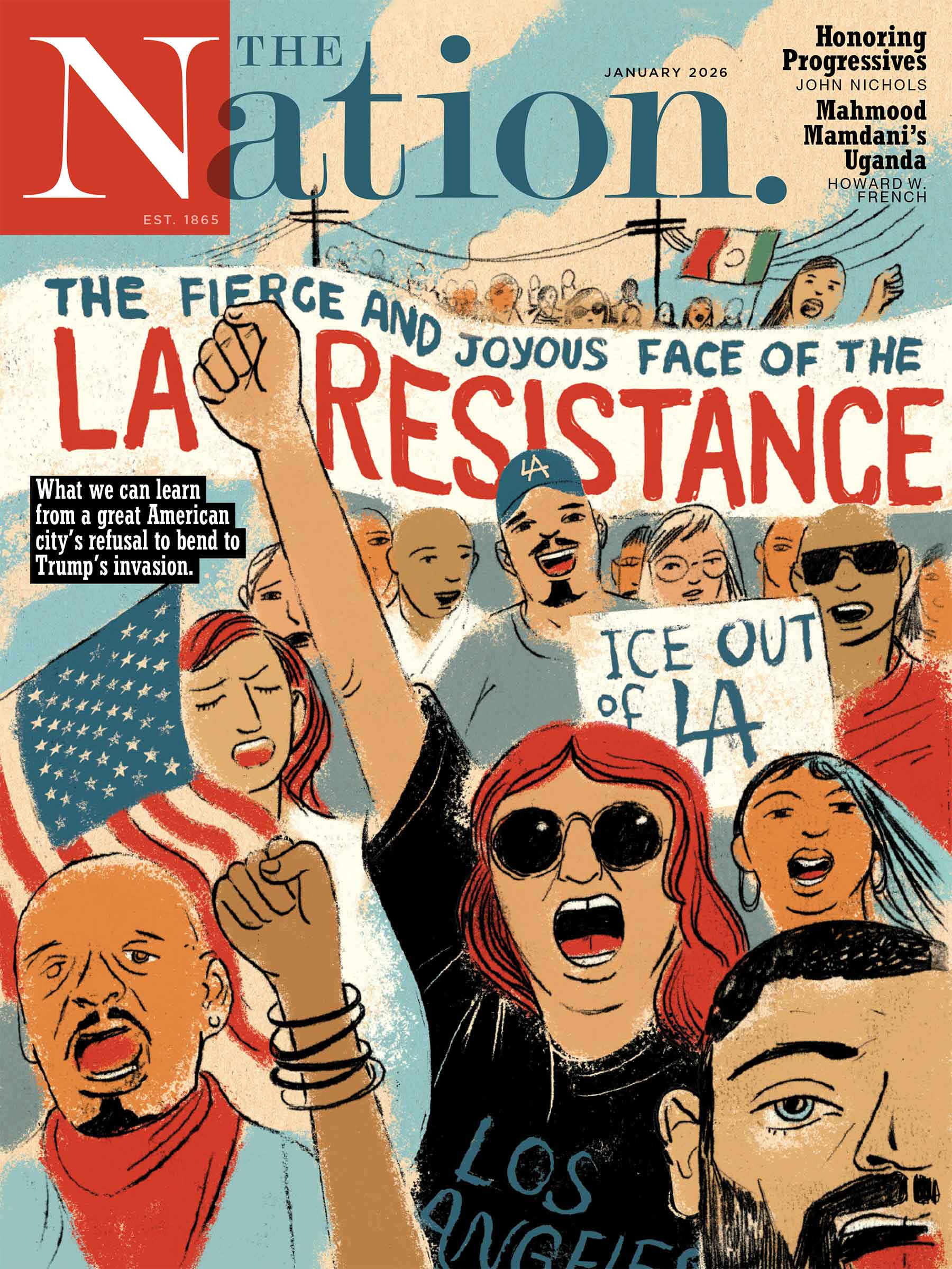How the Wildfires Could Reshape the Climate Movement in California
As the city debates how it can best address the impacts of increasingly devastating natural disasters, organizers hope to seize the moment.

The Eaton fire in the Altadena area of Los Angeles County, California on January 8, 2025.
(Josh Edelson / Getty)
When the Eaton Fire on January 7 forced brothers Jackson Brooks, 17, and Niko Brooks, 19, to evacuate their home, they watched from afar as the fires swept through entire neighborhoods.
“We felt very helpless, because we felt like we had to be back home, protecting our home, protecting our community, because it was falling apart in front of us,” Jackson said.
In the following days, the brothers started a GoFundMe to purchase water, clothing, and other necessities for people who had lost their homes, and created an Instagram account to organize volunteers—mostly fellow high school students from around the Altadena-Pasadena area—to help clean up and distribute donations to fire victims.
The Eaton Fire shifted their understanding of the climate crisis. “If I’m being completely honest, I’ve never really thought about climate change too much,” said Jackson. “Seeing the fires and everything that’s happened—how it’s sprung over all of Southern California—is just devastating,” he said. “It’s real. We have proof of it. It’s here, and it’s really affecting everyone.”
“I used to hike in those mountains that are burnt to a crisp every single weekend in high school,” said Niko.
For many Los Angeles residents, January’s wildfires were their most direct experience with the consequences of climate change. As the city debates how it can best address the impacts of increasingly devastating natural disasters, could the fires be a galvanizing moment for the climate movement in Los Angeles?
The role of climate change in California’s intensifying wildfires is well-documented. Fifteen of the top 20 most destructive wildfires in California’s history have occurred in the last decade. The Eaton and Palisades fires, just two of many that have devastated the Los Angeles region in the past two weeks—both rank among the five most destructive in the state’s history, having destroyed over 12,000 structures and displacing hundreds of families.
The current LA wildfire crisis is in part the result of rising temperature across the state and minimal rainfall since July 2024. “Essentially, our area is experiencing whiplash between years of extreme precipitation and years of extreme drought.” said Olivia Sanderfoot, a postdoctoral fellow at UCLA who studies how wildfire smoke impacts birds and other wildlife. While wet years encourage vegetation growth, periods of drought dries out vegetation—creating the conditions for a fire to spread at a deadly pace.
Southern California—particularly LA, surrounded on both sides by mountains—has always been considered fire-prone, with a fire season from June to October that peaks during the summer. But climate change could send Los Angeles into a perpetual fire season. “This is unprecedented for winter time in California to see such,” said Sanderfoot, “to see one mega fire of this size and of this destructive power, much less two.”
Kevin J. Patel, founder of the youth-led environmental organization, OneUpAction, grew up in South Central LA and is no stranger to the effects of climate change. “There’s a multitude of injustices that are happening to our community, having the factories, oil refineries, the nonexistence of green spaces; we’re left with an area that is plagued with air pollution.” Patel said. “And in my sixth-grade year, I was directly impacted by that. I had heart palpitations, so I spent the better part of my sixth-, seventh-, and eighth-grade years in and out of the hospital.”
When the wildfires broke out in LA, Patel had to evacuate to the Bay Area. Though he was not in an evacuation zone, the air quality worsened his preexisting health conditions. “When we look at the effects going forward, we have to really realize that although the more affluent communities were affected by the wildfires, you also have to see how it affects our communities on the southside, in South Central and Crenshaw,” Patel added. “A lot of these communities are not prepared with air purifiers or N95 masks.”
Isaias Hernandez, who advocates for environmental issues on his platform, Queer Brown Vegan, grew up in Sylmar, California—the site of the Hurst Fire, one of the many burning in LA last week. When the fire broke out, Hernandez helped evacuate his elderly parents to his brother’s home in North Hollywood. This was not Hernandez’s first time evacuating from a wildfire in Los Angeles. “There was the Sayre Fire when I was in middle school [in 2008] and I will always remember the whole sky was pitch black, and there was smog,” Hernandez recalled. “It was lunchtime and I was eating this cheese pizza, and black ashes fell on the pizza. I remember looking up to the sky and seeing these large tons of black ashes just falling from the sky and our teachers being like, ‘Get inside.’”
Popular
“swipe left below to view more authors”Swipe →Hernandez recalls his parents’ fear after hearing rumors that ICE agents were at relief shelter zones. For him, the Sayre Fire helped galvanize his own interest in environmental issues, particularly the way in which they intersect with racial and political issues. Yet he is skeptical that the current LA wildfire crisis might galvanize others. “I believe that more people are shifting their values towards conservatism, and also blaming and spreading misinformation on the issues, rather than looking at the issue as an environmental crisis.”
For Nicole Curristan, a third-year environmental science student at UCLA, “nothing has been as salient as these fires in instilling the point that climate change is here right now.” Curristan hopes that the wildfire crisis can help re-galvanize the climate movement. “Our generation specifically, we were just coming into our high school years at the start of the Fridays For Future climate strikes, and now that we’re in college, I feel like we’re on the precipice of more action for climate, especially as we enter a second Trump administration,” Curristan said.
Professor Shannon Gibson, who teaches environmental studies, political science and international relations at the University of Southern California, isn’t as sure. “Social movements and frontline communities have to function in a system where the cards are stacked against them. They don’t have the financial resources that other actors, like governments and big business have, but what they do have, and what we’ve always depended on, is that people power: the ability of communities to come together and to rally and to mobilize around issues that they care so deeply and are so deeply vested in,” Gibson said. “But in prolonged battles like these, it takes a toll. When I see you know, disaster after disaster hitting our already marginalized communities, I worry about that mental toll.”
And in this prolonged battle, the climate movement will contend with a familiar obstacle: President Trump. Even as some of the country’s most populous cities, like Los Angeles, face compounding weather disasters due to climate change, Trump, who has called climate change a “hoax,” has vowed to double-down on fossil fuel extraction.
Already—amid the slew of executive orders Trump signed hours after his inauguration—Trump pulled the United States out of the 2015 Paris climate accords and signed an order titled “Unleashing American Energy” that, among other provisions, eliminates incentives to produce electric vehicles and “encourages energy exploration and production” on federal lands. Trump has also declared an “energy emergency” via executive order, calling for an increase in the country’s energy production—a demand echoed in his inauguration speech’s call for “drill, baby, drill,” in his inauguration speech.
Looking forward, climate activists can take a note from how Los Angeles quickly mobilized in this time of great need to take care of one another, through community organizing that moved beyond raising awareness to on-the-ground action and robust mutual aid.
But first, Curristan emphasizes that meaningful advocacy around climate change must require an acknowledgement of the devastation and loss communities around Los Angeles have experienced over the past weeks: In order for there to be collective action, there must first be collective healing.
“There’s been so much destruction and just violence in an environmental sense that has happened so close to where we go to school, [and] for a lot of people, their homes,” Curristan said. “I think there’s really going to need to be some moment, hopefully a long moment of collective healing and finding some sort of way to come together and take care of each other, find some sort of hope in a collective sense, going forward.”
Disobey authoritarians, support The Nation
Over the past year you’ve read Nation writers like Elie Mystal, Kaveh Akbar, John Nichols, Joan Walsh, Bryce Covert, Dave Zirin, Jeet Heer, Michael T. Klare, Katha Pollitt, Amy Littlefield, Gregg Gonsalves, and Sasha Abramsky take on the Trump family’s corruption, set the record straight about Robert F. Kennedy Jr.’s catastrophic Make America Healthy Again movement, survey the fallout and human cost of the DOGE wrecking ball, anticipate the Supreme Court’s dangerous antidemocratic rulings, and amplify successful tactics of resistance on the streets and in Congress.
We publish these stories because when members of our communities are being abducted, household debt is climbing, and AI data centers are causing water and electricity shortages, we have a duty as journalists to do all we can to inform the public.
In 2026, our aim is to do more than ever before—but we need your support to make that happen.
Through December 31, a generous donor will match all donations up to $75,000. That means that your contribution will be doubled, dollar for dollar. If we hit the full match, we’ll be starting 2026 with $150,000 to invest in the stories that impact real people’s lives—the kinds of stories that billionaire-owned, corporate-backed outlets aren’t covering.
With your support, our team will publish major stories that the president and his allies won’t want you to read. We’ll cover the emerging military-tech industrial complex and matters of war, peace, and surveillance, as well as the affordability crisis, hunger, housing, healthcare, the environment, attacks on reproductive rights, and much more. At the same time, we’ll imagine alternatives to Trumpian rule and uplift efforts to create a better world, here and now.
While your gift has twice the impact, I’m asking you to support The Nation with a donation today. You’ll empower the journalists, editors, and fact-checkers best equipped to hold this authoritarian administration to account.
I hope you won’t miss this moment—donate to The Nation today.
Onward,
Katrina vanden Heuvel
Editor and publisher, The Nation
More from The Nation

The Fight for the Last Wild Salmon The Fight for the Last Wild Salmon
In Alaska, the last stronghold for wild salmon, Native tribes and conservationists are working to save the fish from both climate change and decades of corporate greed.

What Your Cheap Clothes Cost the Planet What Your Cheap Clothes Cost the Planet
A global supply chain built for speed is leaving behind waste, toxins, and a trail of environmental wreckage.

The UK’s Climate National Emergency Briefing Should Be a Wake-Up Call to Everyone The UK’s Climate National Emergency Briefing Should Be a Wake-Up Call to Everyone
The briefing was a rare coordinated effort to make sure the media reflects the science: Humanity’s planetary house is on fire, but we have the tools to put that fire out.

AI Will Only Intensify Climate Change. The Tech Moguls Don’t Care. AI Will Only Intensify Climate Change. The Tech Moguls Don’t Care.
The AI phenomenon may functionally print money for tech billionaires, at least for the time being, but it comes with a gargantuan environmental cost.

Backsliding in Belém Backsliding in Belém
Petrostates at COP30 quash fossil fuel and deforestation phaseouts.

Wake Up and Smell the Oil. Your Nation’s Military Is Hiding Its Pollution From You. Wake Up and Smell the Oil. Your Nation’s Military Is Hiding Its Pollution From You.
A fact all but ignored at COP30.


